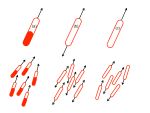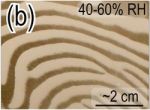News
EPJ B Highlight - Graphene mini-lab
- Details
- Published on 03 November 2012

Physicists study fast-moving electrons in graphene as a model laboratory for massless particles
A team of physicists from Europe and South Africa showed that electrons moving randomly in graphene can mimic the dynamics of particles such as cosmic rays, despite travelling at a fraction of their speed, in a paper just published in EPJ B.
Andrey Pototsky and colleagues made use of their knowledge of graphene, which is made of a carbon layer, one atom thick, and packed in a honeycomb lattice pattern. In such material the interaction of electrons with atoms changes the effective mass of the electrons. As a result, the energy of electrons in graphene becomes similar to the photon energy.
EPJ Plus Highlight - LARES: a nearly ideal satellite to test fundamental physics
- Details
- Published on 03 November 2012

The discovery of the accelerating expansion of the Universe, thought to be driven by a mysterious form of ‘dark energy’ constituting most of the Universe, has further revived the interest in testing Einstein’s theory of General Relativity (GR). Frame-dragging in the gravitational field generated by a rotating body or by a current of mass-energy is one of the most fascinating phenomena predicted by GR. The recently launched LARES (Laser RElativity Satellite) space mission is aimed at improving of about an order of magnitude the accuracy of the previous frame-dragging measurements by the LAGEOS and LAGEOS 2 satellites, using GRACE-derived Earth gravity determinations. After some years of orbital analysis of LARES, LAGEOS and LAGEOS 2 satellite laser ranging data, we should reach a few percent uncertainty in testing frame-dragging.
EPJ B Highlight - Cocktail achieves superconducting boost
- Details
- Published on 31 October 2012

Scientists have now developed a high-performance material by mixing iron and selenium
Physicists describe how they have synthesized a new material that belongs to the iron-selenide class of superconductors, called LixFe2Se2(NH3)y, in a paper just published in EPJ B. The work was carried out by Ernst-Wilhelm Scheidt from the University of Augsburg and colleagues. This material displays promising superconducting transition temperatures of 44 Kelvins (K) at ambient pressure, thus improving upon traditional copper-based high-temperature superconductors.
EPJ E Highlight - Enigmatic Nematics
- Details
- Published on 31 October 2012

The law of hydrodynamics governing the way internally driven systems behave could explain their complex structure
Physicists use hydrodynamics to understand the physical mechanism responsible for changes in the long-range order of groups of particles. Particularly, Aparna Baskaran of Brandeis University, Massachusetts, USA, and Cristina Marchetti of Syracuse University, New York, USA, focused on ordered groups of elongated self-propelled particles. They studied the breakdown of long-range order due to fluctuations that render them unstable and give rise to complex structures, in a study just published in EPJ E within the topical issue on Active Matter.
EPJ E Highlight - DNA’s double stranded stretch
- Details
- Published on 27 October 2012

Models simulate what happens to DNA strands when stretched to the breaking point
Theoretical physicists like to play with very unconventional toys. Manoel Manghi from Toulouse University in France and his colleagues have adopted a seemingly playful approach to examining what happens to a double stranded molecule of DNA when it is stretched to the breaking point, in a study about to be published in EPJ E. Instead of using optical tweezers to stretch DNA as previously done in experimental settings, the authors focused on using a theoretical model to account for the structural deformations of DNA and determine how its mechanical characteristics could explain certain biological processes.
EPJ E Highlight - The hidden threat posed by inconspicuous stripes
- Details
- Published on 23 October 2012

Physicists investigate the cause of striped patterns formed by fine particles deposited on surfaces
Patterns fascinate. Particularly stripes. Found in nature in zebras, they are also found in the most unlikely places, such as powdered drugs’ mixing vessel walls. In an article just published in EPJ E, Nirmal Thyagu and his colleagues from Rutgers University, New Jersey, USA, propose a traffic model to predict the formation of different patterns, ranging from stripes to spots.
EPJ Photovoltaics indexed in CAS
- Details
- Published on 23 October 2012
EPJ Photovoltaics is now indexed in the Chemical Abstracts Service (CAS) database.
Chemical Abstracts Service (CAS) monitors, indexes, and abstracts the world's chemistry-related literature and patents. These databases offer many scientific disciplines, including biomedical sciences, chemistry, engineering, materials science, and more.
EPJ Plus Focus Point - Interdisciplinary Science with Cosmic Rays
- Details
- Published on 21 October 2012
Interdisciplinary Science with Cosmic Rays Guest Editors: Antonio Bueno and Lawrence Wiencke
The Pierre Auger Observatory, located near the base of the Argentinean Andes, is the largest cosmic ray facility in the world. Spanning 3,000 km2, its complementary detector systems use the troposphere as a giant calorimeter to measure the highest-energy subatomic particles known to mankind. Because this instrument observes both the earth and the cosmos in unique ways, its interdisciplinary significance extends to the atmospheric and earth sciences. The articles comprising this EPJ Plus Focus Point highlight examples of observations in these fields and discuss several beginning projects. As shown in the introductory remarks (A. Watson), these articles are intended to reach a broad audience, both in order to stimulate discussion and to encourage new collaborative efforts of an interdisciplinary nature.
The observatory is introduced by Wiencke et al. with examples such as a major earthquake that was observed by the observatory’s surface detector. A proposed seismic sensor array to be located at the observatory is also described by Ruigrok et al. The observatory’s ground-based atmospheric monitoring program is arguably the most extensive in the southern hemisphere. Aerosols and clouds play a complicated role in the earth’s climate and there are fewer detailed measurementsavailable from the southern hemisphere. The measurements of the atmospheric molecular component are described by Keilhauer et al., including a comparison between local radiosonde measurements and extrapolations from the Global Data Assimilation System. The subsequent article by Louedec et al. reviews methods used at the observatory to characterizeaerosols and atmospheric clarity, and outlines a proposed project to study the origin and transport of iron-rich aerosols that play a role in biological processes in the southern ocean. The article by Tonachini et al. discusses the lidar systems at the observatory. The demonstration how measurements of clouds are used to ground truth comparisons with GOES satellite datais the subject of the article by Chirinos et al. Next, Mussa et al. describe the serendipitous observation of transient luminescent events (ELVES) created above some thunderstorms. This article also demonstrates a detailed measurement of anELVE’s time evolution using the observatory’s air fluorescence detector. Finally, cosmic ray air showers have been proposed as a possible trigger mechanism for lightning. A closing article (Brown et al.) discusses a lightning detection system planned to test this hypothesis.
To view this focus point and others already published, please click here.
EPJ Plus Focus Point - Deep Underground Science Laboratories and Projects
- Details
- Published on 21 October 2012
Deep Underground Science Laboratories and Projects Guest Editor: Alessandro Bettini
Physicists have developed a theoretical description of the elementary building blocks of matter and of the basic forces of Nature, called the Standard Model. It is the most comprehensive theory ever developed and has been tested with high precision up to energies of a few hundred times the proton mass. A new collider, the LHC, has started to work at still higher energies, discovering the last missing element of the SM, the so-called Higgs boson. However we know already that this, and any accelerator of the future, will not be sufficient.
The reason is that three of the four basic forces of Nature, namely strong, electromagnetic and weak, seem to become equal at high energies. Unfortunately the energy scale of the unification is extremely high, so high that we will never be able to reach it with an accelerator. Even higher is the Planck scale, the Big Bang energy, at which, presumably, also the fourth force, gravitation, becomes unified. We can exploit an indirect way, because phenomena characterised by a high-energy scale do, in fact, happen naturally even at the lower, every day, energies. However the higher their intrinsic energy scale is, the more rarely they happen.
The deep underground laboratories are dedicated to the search for these natural, but extremely rare nuclear and subnuclear phenomena, requiring a very low radioactive background environment. The background is due to cosmic rays and to decays of radioactive nuclei present, in traces, in all materials. Underground laboratories, shielded from cosmic and radioactive radiations, have been built in Europe, Japan and North America. More are planned in China, India and South America. They differ in size, depth and organisation, but their scientific programmes are similar and complementary. Other disciplines, like geodynamics and biology, can profit from the unique environment of the underground facilities.
The author of the paper of each laboratory or project is the Director of the given Lab or the PI of the given project.
To view this focus point and others already published, please click here.
EPJ A Review - Coherent Investigation of Nuclear Data at CEA DAM: Theoretical Models, Experiments, and Evaluated Data
- Details
- Published on 21 October 2012

Dr. Eric Bauge et al describe a body of work accomplished by the CEA/DAM. Their goal is to determine accurate nuclear reaction cross sections for use in neutron transport codes. This work integrates theory and modeling, experiment, computer simulation, and statistical analysis. It involves researchers who thrive on multidisciplinary work, and who are motivated to achieve realistic simulation predictions in nuclear technology applications. Not only has the group succeeded in creating databases of accurate cross sections, but in every aspect of the work significant progress has been made in advancing our understanding of the underlying nuclear physics.





